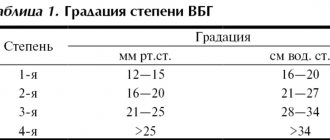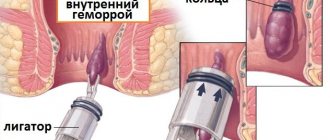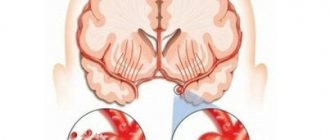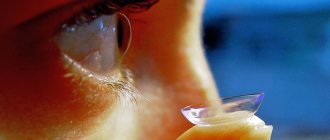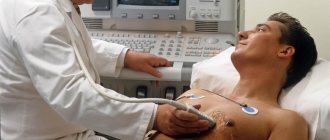Why might my nose bleed?
Nosebleeds are classified into “anterior” and “posterior.” In the first case, the cause is damage to small blood vessels, this type is usually easy to stop. The second case is considered more dangerous; bleeding occurs due to injury to large vessels located deeper in the nose, so it cannot be dealt with at home. If the blood is “spouting”, this is a reason to urgently call an ambulance.
Causes of nosebleeds include:
- nasal injuries;
- thinning of the mucous membrane;
- inflammatory processes in the nasal cavity;
- fragility of blood vessels, heart and blood diseases;
- a sharp increase in blood pressure;
- uncontrolled use of certain medications (anticoagulants, NSAIDs, vasoconstrictor drops for the common cold).
The main advantages of laser coagulation
Laser coagulation is one of the minimally invasive techniques that have a number of advantages over conventional surgical interventions involving soft tissue incisions:
- after the operation there is no need for nasal tamponade;
- with laser vasotomy, the risk of bleeding from the vessels in the nose is eliminated;
- During the procedure, the vessels are sealed, so their rupture is impossible;
- the operation lasts 15-45 minutes;
- very small wounds remain on the surface of the mucous membranes of the nose after the procedure;
- nasal breathing is completely restored within three days after the procedure.
A huge advantage of laser coagulation is a short rehabilitation period. On average, it lasts no more than seven days. After the operation, patients are under the supervision of our specialists for about half an hour and then sent home.
What to do if your nose bleeds?
When bleeding begins, it is important to try not to be nervous, as nervousness causes our heart to beat faster, which leads to more blood loss.
The algorithm for stopping bleeding is as follows:
- Sit up straight, tilt your head forward.
- You should be comfortable: loosen your belt and collar, open the window if necessary.
- Apply a cold, wet towel or ice to your nose and place a warm heating pad on your feet. This will help narrow the blood vessels in your nose and widen them in your legs, which will reduce bleeding.
- Pinch the bleeding vessel: squeeze the wings of the nose with your fingers for 3-5 minutes, the bleeding should stop. Also for this purpose, you can insert a gauze swab pre-moistened in hydrogen peroxide into the nostril.
If you have completed all of the above points and the blood continues to flow, call an ambulance immediately, because even a small loss of blood can lead to fainting.
What should you remember when you have a nosebleed?
- Do not lie down or let your legs be higher than your head - this will increase bleeding;
- Do not throw your head back: a large amount of blood entering the stomach can cause vomiting, in addition, blood can flow into the windpipe and make breathing difficult.
- Once the bleeding has stopped, avoid eating or drinking caffeinated drinks to avoid increased blood pressure and further bleeding.
Preventing nosebleeds
Remember, frequent nosebleeds are a reason to consult a doctor. The specialist will identify the cause of the problem and prescribe treatment, which may include the use of hemostatic agents, as well as medications that improve blood circulation.
To prevent rebleeding, a specialist may recommend:
- Taking medications and vitamins to strengthen blood vessels.
- Proper diet. Adding foods rich in vitamin K and C to the menu. Vitamin K is responsible for blood clotting; parsley, spinach, basil, bananas, avocados, broccoli, bran, etc. are rich in it. Vitamin C strengthens the walls of blood vessels, it is found in large quantities in rose hips, sweet peppers, currants, citrus fruits, etc.
- Activity and moderate physical activity: light exercise in the morning, daily walks in the fresh air, visiting the pool, etc.
Be healthy!
"Capricious" nose
Why do some people cope with a runny nose quickly and easily, while for others it drags on and becomes complicated by troubles? What solutions to the situation does modern medicine offer?
The story is told by the candidate of medical sciences, head of the otolaryngological department of the Lapino Clinical Hospital of the Mother and Child Group of Companies in the capital, Andrey Kuzmich Boklin.
Reason one
ANOMALIES OF THE NASAL CAVITY
As a rule, we are talking about a deviated nasal septum. This condition can be suspected by frequent nasal congestion and difficulty breathing. At the same time, a runny nose arising from colds and acute respiratory viral infections lasts a long time and is complicated by various types of sinus inflammation.
Treatment
The problem is solved surgically. ˇNowadays, minimally traumatic intervention can be performed. It is called septoplasty. The operation is performed without incisions on the facial skin. Through a puncture in the nasal cavity. And the final success is determined by the postoperative period. To speed up nasal healing, advanced clinics today use “breathable” tampons and silicone stents. This relieves patients from discomfort. And it allows you to reduce their hospital stay to a day.
Reason two
LOW VASCULAR TONE IN THE NOSE
In medical language, this condition is called vasomotor rhinitis. And it develops more often in young people with vegetative-vascular dystonia and low blood pressure. It also occurs with some endocrine problems. The essence of this type of runny nose is that a person’s so-called “nasal cycle” changes. Normally, the nasal turbinates skillfully regulate the volume of inhaled air, changing in size due to filling with blood. In this way they react to air temperature and humidity. In this case, the vascular tone in one of the nasal conchas is greater than in the other. And it changes approximately every hour.
But with “weak” vessels, this cycle is lengthened or shortened. “Unreasonable” congestion occurs. Problems with breathing and smell when the weather changes or pressure changes. Even stress can lead to exacerbation of vasomotor rhinitis.
Treatment
It is important to improve the functioning of the vegetative-vascular system as a whole. And from this point of view, hardening, massage of the cervical-collar area, and physical therapy are useful. Special drops and sprays are required to strengthen the walls of blood vessels and relieve swelling. As well as inhalations and physiotherapy. In particular, phonophoresis with drugs, UHF and laser.
If conservative treatment is not successful, endoscopic ENT surgery comes to the rescue. The purpose of the operation is to destroy excess choroid plexuses in the nose and prevent them from expanding due to filling with blood.
Technically, such manipulation is carried out in different ways - using ultrasound, radio waves or laser. They all have their pros and cons. But today radio wave exposure is considered the most effective.
Reason three
ALLERGY
In this case, nasal discharge usually remains clear. And in addition to them, a person is bothered by an itchy nose and sneezing attacks.
It is also common for the eyes to become red and watery. There is a sore throat and a dry cough. Unfortunately, against the background of prolonged allergies, irreversible changes can occur in the nose. Its mucous membrane grows, forming polyps. And they, in turn, begin to interfere with proper breathing and contribute to chronic inflammation of the paranasal sinuses. In this situation, it is impossible to do without an accurate diagnosis. Therefore, not only an x-ray or ultrasound is performed, but also a computed tomography scan of the sinuses. And then, to clarify the subtleties, an endoscopic examination of the nasal cavity and nasopharynx. In addition, a culture of nasal discharge and blood tests are done. This allows you to identify or exclude a bacterial infection.
Treatment
The basis of the fight against allergic rhinitis is antihistamines - tablets, sprays and drops. Seawater-based sprays should be used 2-4 times a day. They help cleanse the nasal cavity of allergens and germs. Vasoconstrictor drops relieve the symptom of congestion. But they should not be used for more than 5–7 days. In difficult cases, hormonal drugs in the form of sprays are also used. They effectively relieve swelling and allergic inflammation in the nose. But they should be used only as prescribed by a doctor and for at least a month.
Drug treatment goes well with physical therapy. As a rule, this is phonophoresis or electrophoresis with antihistamines. These procedures cleanse the nasal cavity and the respiratory tract in general. The so-called salt mines and inhalations are very effective.
However, you need to keep in mind: you can completely recover from allergic rhinitis only by getting rid of the allergen. Or, if this is not possible, undergo a special “vaccination” from an allergist. Then sensitivity to this substance or product will decrease to a minimum.
Reason four
DEPENDENCE ON MEDICINES
In this case, the cause of problems is long-term use of the medicine.
The most common culprits of medicinal rhinitis are vasoconstrictor drops and sprays, designed, on the contrary, to ease breathing during a runny nose.
In addition to the addictive effect, these seemingly harmless drugs can increase heart rate and worsen the condition of people with hypertension and glaucoma.
In addition, few people know that high blood pressure pills and some psychotropic drugs can cause a drug runny nose.
Treatment
The only way out of this situation is to cancel the causative drug, or replace it with an alternative, but safe one. However, in the first days about: swelling, difficulty breathing, difficulty distinguishing odors. Sprays can help here
based on sea water and inhalation. As well as general strengthening self-help measures - gymnastics, hardening, breathing according to Strelnikova.
And in a completely extreme case - if the nose still does not breathe - this is a small surgical correction. In meaning and technically, it resembles that of vasomotor rhinitis.
Reason Five
THINNING OF THE NASAL MUCOSA
Doctors call this problem atrophic rhinitis. It may be associated with heredity or due to poor ecology. Working in hot, dry, dusty rooms is especially unfavorable in this regard. But in addition, this type of runny nose may indicate a deficiency of vitamins or iron in the body.
A specific sign of such a runny nose is the appearance of dry crusts in the nose and periodic nosebleeds.
Treatment
The first step is to identify the factors causing the disease and eliminate them. Then local treatment is prescribed. It includes drugs that soften crusts in the nose. These are sprays based on sea water and vegetable oils. They need to be used for a long time. Ointments containing vitamins, microelements and healing substances are also useful for a “dry” nose. They improve nutrition of the mucous membrane, due to which the structure and function of the organ is restored.
Another component of the treatment regimen is agents that reduce the viscosity of nasal discharge. These are drugs with fluimucil, alkaline inhalations or simply irrigating the nose with alkaline solutions.
Vitamins and biostimulants also play an important role. They mobilize the body's regenerative properties and promote healing of nasal tissue.
Reason six
POLYPS IN THE NOSE
These formations are nothing more than overgrown areas of the mucous membrane of the nasal cavity or sinuses. For the time being, they can behave quietly, without showing themselves in any way. But as they grow and if infections occur, they provoke the development of a special type of runny nose - polypous rhinosinusitis.
Computed tomography and endoscopic examination of the nasal cavity help clarify the diagnosis, as well as measure polyps with millimeter accuracy.
Treatment
There are both conservative and surgical treatments for this problem. However, an integrated approach is most effective.
First, the doctor removes the polyps themselves. The operation is performed through the nose, without incisions and does not leave any marks on the face.
And then outpatient treatment is carried out. Its purpose is to cleanse the nasal cavity and restore damaged tissues using
special sprays. Slow down the growth of new polyps in the nasal cavity.
For this purpose, metered dose inhalers are used, which need to be used to irrigate the nasal cavity every day for at least three
months. These are hormonal in nature. But there is no need to be afraid of their long-term use. They act directly on the mucous membrane of the nasal cavity and sinuses and are not absorbed into the blood.
You can download the article in .pdf format here
Preparing for surgery
Despite the low-impact nature of laser coagulation, doctors at our clinic approach its preparation with the utmost seriousness. First, the patient is scheduled for a consultative visit to a specialist, where he determines the indications for correction, explains to the patient the essence of the future intervention and warns about the likely consequences.
Before surgery, each patient at the clinic must pass the prescribed tests and, if necessary, undergo a diagnostic examination. After all this, the specialist conducts a second consultation and sets a date and time for the procedure.
In the process of preparing for surgery, the patient is prohibited from:
- drink alcohol;
- take medications to thin your blood.
It is very important to listen to all doctor's recommendations. Otherwise, the risk of complications increases several times.
Progress of the operation
Our clinic employs the best specialists in the city of Krasnodar. Before surgery, the patient's blood pressure is measured again and the procedure is explained. The manipulation is performed in the operating room under local anesthesia. Patients with a vulnerable psyche are given sedatives.
During the operation:
- the patient takes a comfortable vertical body position with the head end raised;
- breathing should be done through the mouth, which will prevent vapors from entering the lungs;
- if necessary, during laser vasotomy manipulation, a smoke evacuation device operates;
- laser cauterization occurs inside the nasal concha without damaging the integrity of the mucous membranes and cilia;
- if necessary, the operation is performed under the control of endoscopic equipment, which also allows one to evaluate the results of the correction performed.
Laser coagulation of blood vessels in the area of the nasal septum is an absolutely painless procedure. Our surgeons always warn patients that during the procedure they may feel some discomfort or a slight tingling in the nose. Such manifestations are normal and do not pose a threat to human health.


